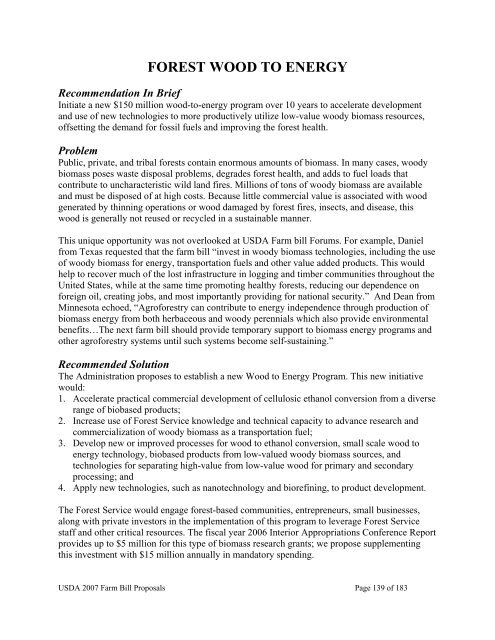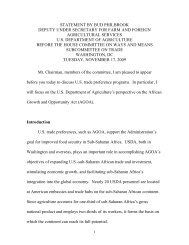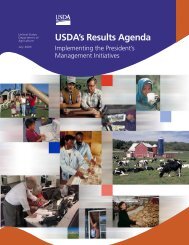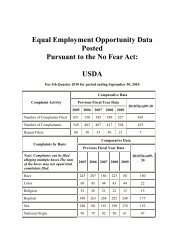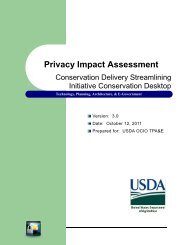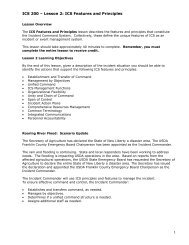USDA 2007 Farm Bill Proposals - US Department of Agriculture
USDA 2007 Farm Bill Proposals - US Department of Agriculture
USDA 2007 Farm Bill Proposals - US Department of Agriculture
You also want an ePaper? Increase the reach of your titles
YUMPU automatically turns print PDFs into web optimized ePapers that Google loves.
FOREST WOOD TO ENERGYRecommendation In BriefInitiate a new $150 million wood-to-energy program over 10 years to accelerate developmentand use <strong>of</strong> new technologies to more productively utilize low-value woody biomass resources,<strong>of</strong>fsetting the demand for fossil fuels and improving the forest health.ProblemPublic, private, and tribal forests contain enormous amounts <strong>of</strong> biomass. In many cases, woodybiomass poses waste disposal problems, degrades forest health, and adds to fuel loads thatcontribute to uncharacteristic wild land fires. Millions <strong>of</strong> tons <strong>of</strong> woody biomass are availableand must be disposed <strong>of</strong> at high costs. Because little commercial value is associated with woodgenerated by thinning operations or wood damaged by forest fires, insects, and disease, thiswood is generally not reused or recycled in a sustainable manner.This unique opportunity was not overlooked at <strong><strong>US</strong>DA</strong> <strong>Farm</strong> bill Forums. For example, Danielfrom Texas requested that the farm bill “invest in woody biomass technologies, including the use<strong>of</strong> woody biomass for energy, transportation fuels and other value added products. This wouldhelp to recover much <strong>of</strong> the lost infrastructure in logging and timber communities throughout theUnited States, while at the same time promoting healthy forests, reducing our dependence onforeign oil, creating jobs, and most importantly providing for national security.” And Dean fromMinnesota echoed, “Agr<strong>of</strong>orestry can contribute to energy independence through production <strong>of</strong>biomass energy from both herbaceous and woody perennials which also provide environmentalbenefits…The next farm bill should provide temporary support to biomass energy programs andother agr<strong>of</strong>orestry systems until such systems become self-sustaining.”Recommended SolutionThe Administration proposes to establish a new Wood to Energy Program. This new initiativewould:1. Accelerate practical commercial development <strong>of</strong> cellulosic ethanol conversion from a diverserange <strong>of</strong> biobased products;2. Increase use <strong>of</strong> Forest Service knowledge and technical capacity to advance research andcommercialization <strong>of</strong> woody biomass as a transportation fuel;3. Develop new or improved processes for wood to ethanol conversion, small scale wood toenergy technology, biobased products from low-valued woody biomass sources, andtechnologies for separating high-value from low-value wood for primary and secondaryprocessing; and4. Apply new technologies, such as nanotechnology and biorefining, to product development.The Forest Service would engage forest-based communities, entrepreneurs, small businesses,along with private investors in the implementation <strong>of</strong> this program to leverage Forest Servicestaff and other critical resources. The fiscal year 2006 Interior Appropriations Conference Reportprovides up to $5 million for this type <strong>of</strong> biomass research grants; we propose supplementingthis investment with $15 million annually in mandatory spending.<strong><strong>US</strong>DA</strong> <strong>2007</strong> <strong>Farm</strong> <strong>Bill</strong> <strong>Proposals</strong> Page 139 <strong>of</strong> 183


